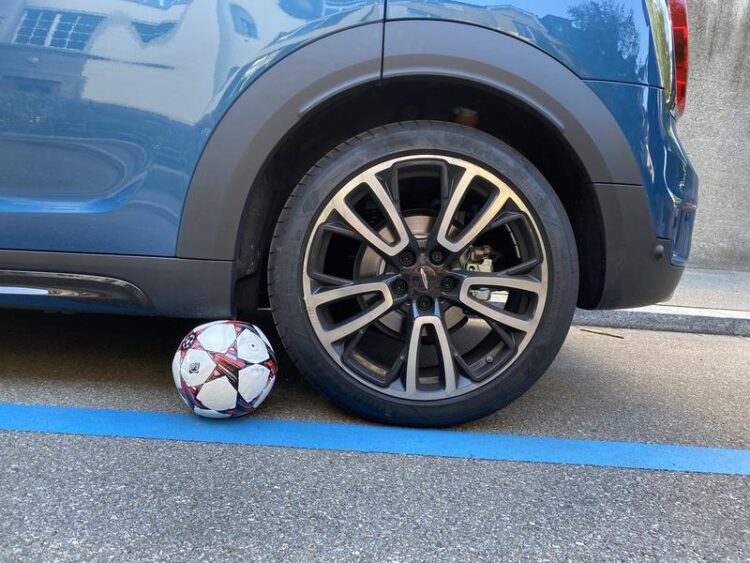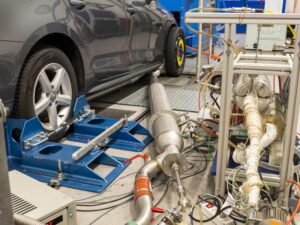Braking dust

Particulate matter source: The brakes of a car emit particles of metal oxide.
Andrea Six / Empa
The broad introduction of particle filters reduced the emission of combustion generated fine and ultrafine particles significantly. As a result, brake disc and tire abrasion are moving into the focus of public health experts and engineers, given their health harming potential. There is still a major challenge, though: How can the quantity and size of brake dust particles be measured correctly? Empa researchers are currently developing a sophisticated method.
The VW Jetta Hybrid on the chassis dynamometer in Empa’s Automotive Powertrains Technologies Laboratory had a couple of years of duty as a fleet vehicle. Strapped into the test chamber, it has been part of a new research purpose since July 2020: The goal is to generate brake dust, strictly following the standardized WLTP driving cycle, is the cycle that is also used to determine exhaust emissions.

Gian Vaitl / Empa
The interest in brake dust measurements is fairly recent: In June 2016, a department of the UN Economic Commission for Europe (UNECE) known as the “Particle Measurement Programme Informal Working Group” (PMP IWG) decided that it was time to develop a generally applicable test procedure for brake dust that would reliably determine the mass and the number of the emitted particles. Since then, a number of research institutions, vehicle manufacturers and specialized companies for testing equipment have addressed the topic. However, there some severe challenges to tackle.
Thrown in all directions
Unlike an exhaust pipe, which reliably emits gases in a given direction, a rotating brake disc distributes the particles in all possible directions. So you first have to collect the particles and then introduce them in a well-defined flow towards a particle analyzer. During this process losses have to be minimized: Neither fine particles should be escape, nor should coarse particles remain in the pipes.
Two further complications arise: The brakes of a vehicle are attached to a rotating drive shaft, which must be carefully sealed for the measurement so that no particles are lost. In parallel a brakes have t be cooled. On the road, the airstream together with ventilation lamellas inside the brake disks provide a cooling breeze. A fully enclosed brake on a test bench, by contrast, can heat up quickly – and would then yield completely different particles than in real everyday traffic. Such an analysis would thus be of little value.
Measure all emissions at the same time
The UNECE’s PMP IWG working group solves the problem by simplification: The desired brake tests are to be carried-out in completely enclosed test stands. Such test stands exist. They resemble large cabinets, in which brake discs and brake pads rub against each other. Only one component is tested, not the entire car.
“We are going to try out another way,” says Panayotis Dimopoulos Eggenschwiler, who is designing the test setup at Empa. “We want to measure all emissions of a vehicle simultaneously during a test drive on the chassis dynamometer. This is much more meaningful than data from an isolated brake tester, which must then be converted to real-world conditions”.
An airy bearing targeted design
Together with Daniel Schreiber, an engineer by training, Dimopoulos Eggenschwiler has developed the Empa version of the test, the results of which must now stand up to comparison with other international research teams. At Empa an entire vehicle is being tested, the VW Jetta Hybrid mentioned above. The brake of the right front wheel was enclosed in a specially designed metal housing. A compressed air pipe conveys large quantities of cooling air into the metal casing from the front end of the car; at the same time the air serves as the transport medium for the emitted brake particles. These are directed into a tube about along the vehicle. After a short flight time they land in a 13-stage cascade impactor, a special instrument that sorts particles according to size. Subsequently, the particle fractions can be chemically analyzed by weight. If necessary, their morphology and composition can also be examined using an electron microscope, for instance.
“In preliminary tests, we have already determined what of consisting elements of the brake particles,” says Dimopoulos Eggenschwiler. “It is mainly iron oxide, which originates from the brake disc, and a number of further oxides and species containing aluminum, magnesium, calcium, potassium and titanium, which stem from the brake pads.” In addition to coarse, particles, there are also smaller particles that can be inhaled and can enter the lungs.
Do hybrid vehicles brake differently?
Now that the measuring process is running on a stable basis, the VW Jetta will initially be operated according to the legally prescribed WLTP cycle and will supply brake particles to the cascade impactor. Further test series are planed after that. “We want to find out, for example, whether hybrid vehicles brake differently compared to cars with conventional powertrain systems and hence result in different emissions,” explains the project leader. Hybrid vehicles are also capable of braking through their electric motor and, therefore, need to use their mechanical brakes much less frequently. On the other hand, hybrid vehicles have a higher mass. “With the results of our measurements, it will be possible to optimize the operating modes of future generation vehicles and keep brake dust emissions under better control than today”.
Wissenschaftliche Ansprechpartner:
Dr. Panayotis Dimopoulos
Automotive Powertrain Technologies
Phone +41 58 765 4337
Panayotis.Dimopoulos@empa.ch
Editor / Media Contact
Rainer Klose
Communication
Phone +41 58 765 47 33
redaktion@empa.ch
Weitere Informationen:
https://www.empa.ch/web/s604/feinstaub-beim-bremsen Empa Media release
Empa Youtube Video
Media Contact
All latest news from the category: Ecology, The Environment and Conservation
This complex theme deals primarily with interactions between organisms and the environmental factors that impact them, but to a greater extent between individual inanimate environmental factors.
innovations-report offers informative reports and articles on topics such as climate protection, landscape conservation, ecological systems, wildlife and nature parks and ecosystem efficiency and balance.
Newest articles

Parallel Paths: Understanding Malaria Resistance in Chimpanzees and Humans
The closest relatives of humans adapt genetically to habitats and infections Survival of the Fittest: Genetic Adaptations Uncovered in Chimpanzees Görlitz, 10.01.2025. Chimpanzees have genetic adaptations that help them survive…

You are What You Eat—Stanford Study Links Fiber to Anti-Cancer Gene Modulation
The Fiber Gap: A Growing Concern in American Diets Fiber is well known to be an important part of a healthy diet, yet less than 10% of Americans eat the minimum recommended…

Trust Your Gut—RNA-Protein Discovery for Better Immunity
HIRI researchers uncover control mechanisms of polysaccharide utilization in Bacteroides thetaiotaomicron. Researchers at the Helmholtz Institute for RNA-based Infection Research (HIRI) and the Julius-Maximilians-Universität (JMU) in Würzburg have identified a…



